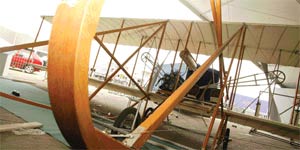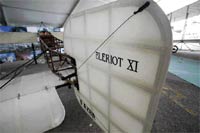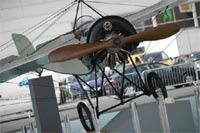As everyone at Le Bourget celebrates the first 100 years of flight - it's too simple to forget that it's still - just - less than a century since powered flight was invented. Imagine what the brothers' Wright would have made of the scenes - on the ground and in the air - at a modern-day airshow.
It was on the morning of 17 December 1903 that Orville Wright clattered into the air over the lonely Kill Devil Hills sand dunes near Kitty Hawk on the coast of North Carolina. Watched by his brother Wilbur, he set in motion an unstoppable leviathan that has grown, in less than 100 years, into the world-shrinking aviation industry we know today.

The Wright 'Flyer' was powered by a four-cylinder water-cooled engine of the brothers' own design and it produced 12hp from a weight (including all accessories, water and fuel) of a little more than 200lbs (91kg).
Wingspan
The first flight - witnessed by the staff of the nearby Kill Devil Life Saving Station - lasted for a mere 12 seconds and covered around 120ft (36.5m) - less than the wingspan of today's twin-aisle airliners! Orville and Wilbur flew four times that day and their longest flight, which lasted almost a minute, covered more than 850ft (260m). The pace of rapid development was already increasing.
News of the first heavier-than-air powered flight was slow to be communicated around the world, as nobody believed that it had really happened. Unfortunately, the Flyer was wrecked by a gust of wind after the fourth flight, so the brothers had to return to the drawing board, and their business as bicycle designers and repairers, in Dayton, Ohio. The second Flyer was ready in mid-1904 and was tested from a large field near the Brothers' Dayton home although considerable problems were experienced in turning; the aircraft invariably stalling and crashing, fortunately without serious injury.
During the winter of 1904-5, the brothers experimented in a rudimentary wind tunnel and discovered that the interlinking of the wing-warping controls with the rudders resulted in an uncontrollable turn-stall-spin-crash sequence. Once the controls were separated, everything was resolved and flights of the third Flyer were far more reliable. Indeed, the new aircraft was able to turn, bank and make circuits and figures-of-eight with ease. On 5 October, 1905, Wilbur made one flight which lasted 38 minutes and covered more than 24 miles. But despite local farmers becoming accustomed to seeing a craft in the sky, the world at large knew little or nothing of the brothers' sensational achievements.
It was not until 1908, when the US War Department showed an interest and Wilbur demonstrated one of his Flyers in France that the world's media started to take an interest. Around the globe, newspapers were shrieking the news and the brothers became overnight celebrities, half a decade after their initial ascent. It was the outbreak of war in Europe in August 1914 that provided the impetus that the embryonic aviation industry required.
The Great War changed aviation so completely that even now it is hard to comprehend how much flying developed during the four years leading up to the Armistice in 1918. From flimsy 'string and sealing-wax' contraptions, to the relatively high-speed weapons of war with conventional three-axis controls, was a massive leap into the future.
Immediately after the conflict, in 1919, Britons John Alcock and Arthur Whitten Brown flew across the Atlantic Ocean in a converted Vickers Vimy twin-engined bomber.
And it was this, perhaps more than any other event since Louis Bleriot's 1909 dash across the English Channel in a monoplane of his own design, that fuelled the cycle of world-shrinking which continues to this day. With a large number of surplus military aircraft readily available, it is not surprising that the decade of the Wall Street Crash should also witness the birth of general aviation.

Relatively docile, but aerobatic, airframes such as the American Curtis Jenny and the British Avro 504 were commonplace at fairs and airshows and many future candidates for the industry's 'Hall of Fame' took their first flight in one of these ex-military aircraft. In the USA, the 'barnstormers' raised the public profile of aviation to levels unimaginable a few years before.
Newspapers were full of the latest exploits of the pioneers who pushed the boundaries of aviation into realms that the average person could only dream about.
Record-breaking flights filled more columns than most other subjects - and heroic figures such as Amelia Earhart, Amy Johnson and Charles Lindbergh (the first man to fly solo across the Atlantic Ocean in his Ryan monoplane The Spirit of St Louis) became household names. Lindbergh, of course, landed here at Le Bourget at the conclusion of his epic flight.
As happened between 1914-18, the Second World War prompted a virtual cessation of private and general aviation for the duration of hostilities and it was not until 1946 that another batch of aircraft 'surplus to military requirements' came onto the market and the flying clubs began to operate from airfields around the world.
Soon, the unsophisticated 'string and sealing wax' wooden aircraft, so beloved of the pre-war flyers, were superseded by metal airframes (or 'spam cans' as they have come to be known affectionately by generations of private pilots) many of them built by famous American companies such as Cessna, Piper, Mooney, Grumman and Beech. As anyone who has learned to fly will confirm, there's nothing quite like turning up an airfield on a sunny Sunday morning, collecting the keys and taking off into the wide blue yonder.
It is certainly the closest most people can get to understanding what Orville and Wilbur Wright must have experienced almost a century ago.
As part of this year's centennial commemoration of manned flight, Messier-Dowty (a Snecma Group company and world leader in the design, development and manufacture of landing gear systems) is sponsoring a Wright Flyer 1 replica, constructed by 18 engineering students at the Ecole Supérieure des Techniques Aéronautiques et de Construction Automobile (ESTACA) located in Levallois-Perret, NW of Paris. The full-scale replica is on display at Le Bourget, in the U.S. pavilion, Hall 3, Stand F4-2.
The materials used were chosen in accordance with historical accuracy. Wood, fabric and even reused bicycle parts were employed. Construction of the replica began in December 2002 and took just six months.
Ultimately, the students made every effort not only to recreate the internal and external accuracy of the original Flyer, but also build one that would conform to the original's flying characteristics. Not surprisingly, the only component that deviates from the one used by the Wright brothers is the engine.
Finally, the students hope to pay homage to the pioneers of aviation by flying their replica on 17 December this year, the 100th anniversary of the first powered flight.

Source: Flight Daily News



















